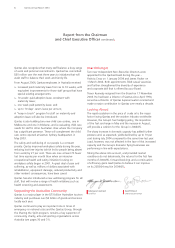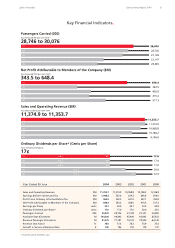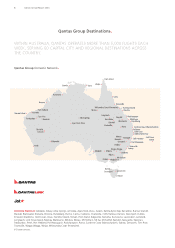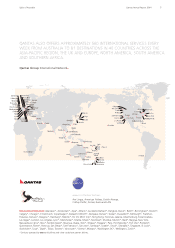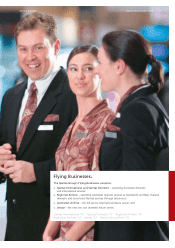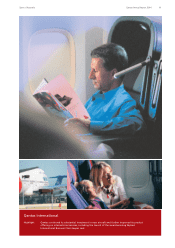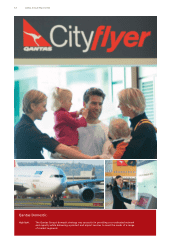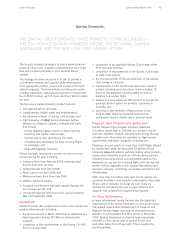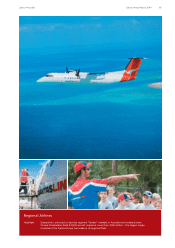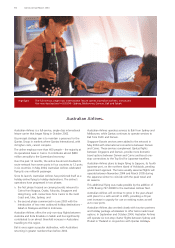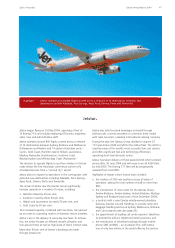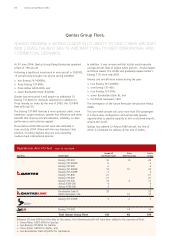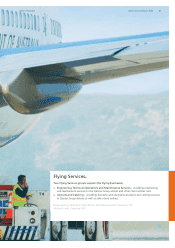Qantas 2004 Annual Report Download - page 16
Download and view the complete annual report
Please find page 16 of the 2004 Qantas annual report below. You can navigate through the pages in the report by either clicking on the pages listed below, or by using the keyword search tool below to find specific information within the annual report.
14 Qantas Annual Report 2004
During the year, QantasLink continued to develop regional
“feeder” markets throughout Australia, connecting the
regional business and leisure markets with the major cities.
In what was the largest single investment the Qantas Group
has made in the regional fleet, QantasLink placed an order
for seven new 50-seat Bombardier Dash 8-Q300 series
aircraft – valued at more than $100 million. Together with
three Dash 8-Q300 aircraft ordered in the previous year,
seven of the new aircraft entered into service during the year
and two others in July and August. The tenth aircraft will
commence operation in November 2004.
The new 50-seat Dash 8 aircraft replace older and less
efficient 36-seat Dash 8s. They have allowed QantasLink to
maintain its competitive advantage by increasing capacity at
peak times and frequency on services to key ports including:
Albury, Armidale, Bundaberg, Burnie, Cairns, Canberra,
Coffs Harbour, Devonport, Emerald, Gladstone, Mildura,
Port Macquarie, Rockhampton, Townsville and Weipa.
In May 2004, the 14 Boeing 717 aircraft that had previously
flown under the QantasLink brand were transferred to the
Qantas Group’s new domestic low cost airline, Jetstar.
As a result, QantasLink now operates a fleet of two aircraft
types – Bombardier Dash 8s and British Aerospace 146
aircraft.
QantasLink employs approximately 1,000 people and has:
operational bases in Sydney, Melbourne, Brisbane, Cairns
and Mildura;
a Dash 8 heavy maintenance facility and administration
centre in Tamworth; and
Dash 8 line maintenance facilities in Mildura, Sydney,
Brisbane and Melbourne.
QantasLink also maintained relationships with a number of
smaller regional airlines.
These partnerships extend the regional network available to
Qantas customers and give customers of these other airlines
access to a range of benefits which include the ability to
make bookings via the Qantas global distribution system,
seamless through check-in to and from the Qantas network
and participation in the Qantas Frequent Flyer program.
Integral to the Regional Airlines business is QantasLink’s
involvement with the regional communities it serves.
QantasLink supports a wide range of rural and regional
charities, schools, sporting organisations and events,
including:
Landcare Australia;
QantasLink National Rugby League Country Clinics,
involving more than 45 of the country’s best rugby league
players travelling to more than 20 regional cities across
three states;
the QantasLink Newcastle Knights;
the Mildura Mavericks basketball team;
Ag-Grow Agricultural Field Days in Emerald; and
Albury-Wodonga’s Flying Fruit Fly Circus.
Jetconnect
Qantas’ domestic New Zealand operations are operated by
Jetconnect, a wholly-owned Qantas subsidiary based in
New Zealand which is managed as part of the Group’s
regional operations.
During 2003/04, Jetconnect’s fleet of Boeing 737-300
aircraft grew from five to eight. This allowed for the
expansion of the New Zealand domestic schedule to also
include the following services:
Auckland-Queenstown;
Christchurch-Rotorua; and
Christchurch-Wellington.
Also during the year:
the two-class full-service domestic operation was
converted to a single, all Economy Class service to provide
a more competitive cost base and to better fit market
needs on the short sectors involved;
a new, more flexible fare structure, similar to the one
introduced in Australia, was also introduced for domestic
New Zealand services; and
from 1 September 2003, Jetconnect commenced
operating some of the Qantas Group’s two-class
trans-Tasman services from Wellington and Christchurch
Regional Airlines
QANTASLINK OPERATES MORE THAN 1,900 SERVICES EACH WEEK TO
49 CAPITAL CITY AND REGIONAL DESTINATIONS ACROSS AUSTRALIA.


